These pages deal with continuous functions such as:
- Powers (exponential)
- Logarithms
- Trigometric functions
Scalar Functions
Here we are looking at functions that map one scalar value to another scalar value. In order to see the function graphically we can show all possible input values as the horizontal axis and the output values as the vertical axis. The translation between the two can then be drawn as a (possibly) curved line.
terminology:
- scalar
- domain
- co-domain
A function f maps elements from domain A to codomain B.

This is denoted as follows,
f: A -> B
Singularities
A singularity is a single point in a function where it does not behave in a continuous way, for example, a step function. Or where the function goes to infinity. There are also more subtle things like a point where the function does not have an inverse and if there are multiple inputs, there may be a point where the inputs are couples and not independent.
Calculating the Value of a Function
If we want to calculate the value of a function for a specific input value we can often use an infinite series. This is often used in devices like calculators and computers to evaluate the value of a function. Although such devices can't calculate an infinite number of terms and therefore don't give the exact value they can get any level of accuracy required by taking enough terms.
Such series are discussed on this page.
| f(x) | f(0) + x f'(0) + x2/2! f''(0)+ x3/3! f'''(0) ... | Maclaurins series |
| f(x + h) | f(x) + h f'(x) + h2/2! f''(x)+ h3/3! f'''(x) ... | Taylors series |
Inverse Function
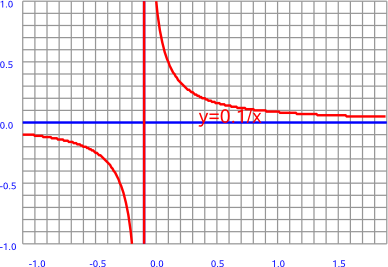
We can see that, for this function, every value of x produces a value of y.
However there is one value on the graph, at x=0, where something strange happens. The value of y jumps from -∞ to +∞ at a single point. This is known as a singularity.
Log and Exponential Functions
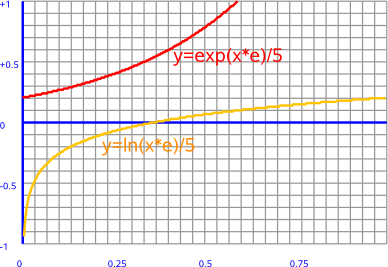
| ln(1+x) | x - x2/2! + x3/3! ... +(-1)r+1xr/(r)! | -1 < x <= 1 |
| exp(x) | 1 + x1/1! + x2/2! + x3/3! ... + xr/(r)! | all values of x |
| exp(-x) | 1 - x1/1! + x2/2! - x3/3! ... | all values of x |
| e | 1 + 1/1! + 2/2! + 3/3! | =2.718281828 |
Trigometric Functions
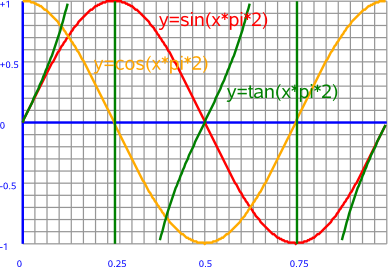
Trig functions are
| sin(x) | x - x3/3! + x5/5! ... +(-1)rx2r+1/(2r+1)! | all values of x |
| cos(x) | 1 - x2/2! + x4/4! ... +(-1)rx2r/(2r)! | all values of x |
Circular Function
If we have an equation like:
x2 + y2 = r2
then the graph is a circle.
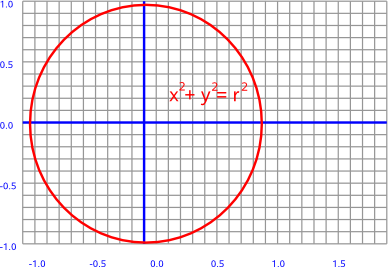
Hyperbolic Function
If we have an equation like:
x2 - y2 = t2
then the graph is a hyperbolic function.
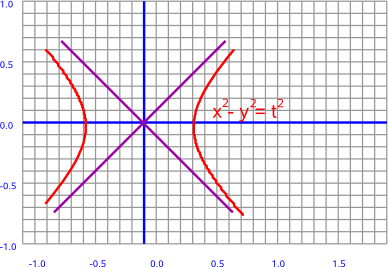
This is the 'signature' of Minkowski space, the simplest example would be double numbers which are like a world with one dimension of space and one dimension of time.
| sinh(x) | x + x3/3! + x5/5! ... +x2r+1/(2r+1)! | all values of x |
| cosh(x) | 1 + x2/2! + x4/4! ... +x2r/(2r)! | all values of x |
Functions in Higher Dimensions
With a higher dimensional quantity like a complex number we need to map every point in a plane to a point in another plane. This is much more difficult to show graphically, one way to do this is to show how horizontal (green) and vertical (red) lines are transformed as shown here for the square function:
| z plane | w plane | |
|---|---|---|
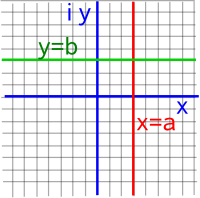 |
--> w=z² |
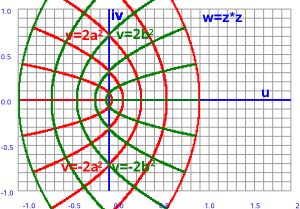 |
Further Reading
For more information about functions of complex domains see this page. For information about functions in different algebras see:
| algebra | dimensions |
|---|---|
| Complex Number Functions | 2 |
| Double Number Functions | 2 |
| Dual Number Functions | 2 |
| Quaternion Functions | 4 |
| Matrix Functions | n² |
| Clifford Algebra Functions |

